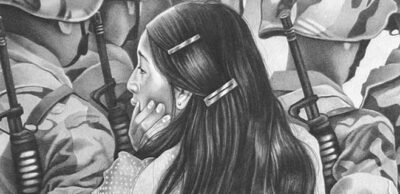Abdication of the Artists: A Retort
Larry Beinhart, author of Wag the Dog, just published an interesting essay titled, Abdication of the Artists. In his piece Beinhart bemoans the complacency of contemporary artists, using the annual exhibit produced by the Woodstock Guild of Artists as an example of the apathy he detests. Beinhart writes:
“This year there were 152 pieces. Some were very clever. Some amusing. A few exhibited very precise draftsmanship. A couple used words and images. There were sculptures—the only rule is size, there’s no restriction on the number of dimensions you can try to reach into. There were hazy landscapes and precise landscapes and some portraits. What struck me the most was what was not there. Not a single piece was political. Or about economics or religion or the environment or mass delusion or science or the media.”
Beinhart then presents a laundry list of the world’s woes;
“New Orleans was destroyed this year. It will not be rebuilt under this administration. Nineteen billion dollars was lost, misplaced, stolen from Iraq while Paul Bremer III was in charge of it. He got the Medal of Freedom afterward. The treasury is being looted. We’re living in the age of the crusades, Christian against Muslim, the 11th Century coming back in the 21st. The Catholic Church is opposing the use of condoms in a country where the rate of HIV infection is 38%. Suburban sprawl is not merely unchecked, it is accelerating. McMansions grow larger. SUV have grown into Humvees and the price of gas goes up.”
He lists many more real world events that should, he argues, elicit a strong political/aesthetic response from the artistic community.
While Beinhart’s complaint about a perceived lack of “political art” is a well meaning appeal for a socially engaged art, it is also a critique that does not fully examine the subject at hand. I dispute the very premise of his essay, that today’s artists have abdicated their social responsibilities and are silent in the face of present realities.
In the last few years I have noticed a surge of artists willing to create socially engaged artworks, so things are not as dire as Beinhart contends—though there is certainly room for improvement. But my main disagreement with Beinhart has to do with his use of the phrase, “political art,” a now common term that implies every other type of art is free of politics.
Beinhart falls into the trap apolitical intellectuals in the art world often find themselves ensnared in; the notion that art is somehow beyond or removed from politics—and that it only becomes political when artists make a concerted effort to make it so. For most people “political art” conjures up visions of clichéd Bush-bashing posters, works effortlessly categorized as propagandistic, easily separated from the mainstream, and so dismissed without difficulty.
It is a label given to a small number of works with a perceived or overt left/liberal bias, and as such, a categorization that deflects identifying the political workings and tendencies of the status quo and its attendant cultural institutions. The term “political art” is never used to describe the works of a David Hockney or Ed Ruscha, and the dominant cultural establishment that backs such artists is on no account referred to as “political,” though it clearly is.
What about the transcendent qualities of art, doesn’t that universality place the arts soaring above the corrupt world of politics and the vulgar materialism of society? Doesn’t the spirituality of art keep it free from the constraints of avarice? Doesn’t the mystical aspect of art place it above earthly and mundane concerns? Yes and no.
Art will always strive to be free of society’s manacles, and it will forever serve as a conduit to humanity’s higher self, but the questions posed here imply an intrinsic relationship between art and material reality. It is an ironclad fact that an artist must eat and pay rent, and so it is also an irreducible fact that we are bound to political arrangements.



